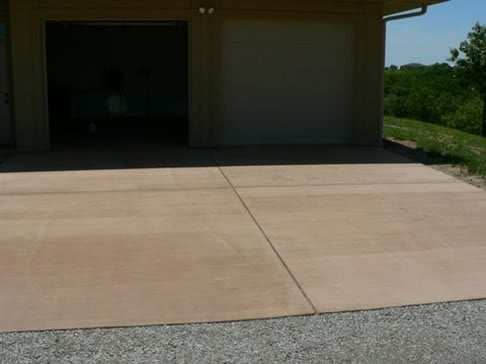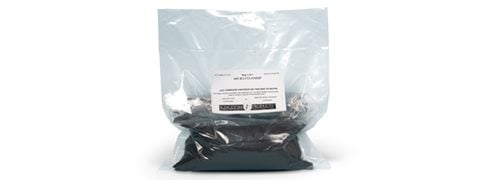- Integral Color Home
- Integral Color vs. Color Hardener for Stamped Concrete
- Tips for Getting the Best Results
- Common Integral Color Issues: Troubleshooting Tips from Expert Chris Sullivan
- Tips for Achieving Consistent Color
- Changing the Color of Integral Concrete
- Related Information:
- Comparison Chart of Concrete Coloring Products
- Product Newsletter Sign Up Today to Receive Monthly Updates
How to Fix Integral Color
Expert Tips on Fixing Integrally Colored Concrete
CHANGING THE COLOR OF INTEGRAL COLORED CONCRETE
Question:
I have an integrally colored driveway that was supposed to be light gray, but the ready mix supplier used the wrong color and now I have a black charcoal driveway. Is there anything I can do to change the color from black to light gray? Part of the driveway is broom finished, while some of it is exposed aggregate.
Answer:
This is one of the hardest issues to deal with. Because integral colors such a durable and "integral" part of the concrete, it's very difficult to change the color. Going from a light to a dark color can be achieved with tinted sealers and colored coatings. But to go from dark to light, without making the surface look like it has been painted, often requires application of a micro-thin colored overlay. However, this is a costly fix and will not work over exposed aggregate. For the rest of the answer, see Changing the Color of Integral Colored Concrete.
INTEGRAL COLOR - DRY PIGMENTS VS LIQUID COLOR
Question:
I am aware that integral color is available in both dry and liquid forms. Is there an advantage to using one over the other? If so, what are they and which is better?
Answer:
The short answer is: It depends. Both dry and liquid integral colors use the same type of pigments (typically synthetic or natural iron oxides). Liquid color just happens to be suspended in water. The decision of which type to use comes down to user preference, availability, and price.
Powdered pigments have been around for 60 years, and they are still the most popular coloring medium, although liquid color has grown in popularity over the last 10 years. Advantages of using dry color in bags or in bulk include wider availability, greater tinting strength, and lower cost. However, liquid pigments offer advantages when it comes to mixing and storing. They are less messy to handle, easier to store, and blend in faster than powders. They also can be dispensed with computer-controlled metering systems, which some ready-mix producers use in their plants for more precise dosing and to simplify the blending of custom concrete colors. The downside is cost. Liquid color is 30% to 40% water on average, so you must buy 1.3 to 1.4 pounds of liquid color to obtain the same results as 1 pound of dry color.
While this discussion is not going to end the debate on the merits of dry vs. liquid integral pigments, it should shed some light on the differences. No matter what form of color you choose for your concrete (powder or liquid), the end result will be the same.
FIXING DISCOLORATION IN CONCRETE WITH INTEGRAL COLOR
Question:
What caused this last pour of integrally colored concrete to be off-color?
Answer:
Asking a few basic questions turned up the following. This was the last of multiple pours, which ran over many weeks. All were tightly controlled for slump and color. A clear water-based curing compound was used on all the slabs. The last slab was rushed a bit since the deadline for opening this area had already passed.
Looking more closely at the other areas of the slab revealed a few blotchy gray areas like the large area in question. This led me to believe that possibly the curing compound was covering the true color. In an effort to save time and money from costly rip out and replacement of the slab (which was the general contractors' first and only recommendation), a simple chemical stripper was used to remove any surface coatings. Sure enough, once a small test area was stripped, the correct color was revealed.
The curing compound had been applied too early and at too high a coverage rate in an effort to save time and cure the concrete faster. This actually backfired by trapping too much moisture, causing the curing compound to haze and turn white. The use of a colored curing compound would have helped in this situation, even at the higher application rate. More information on proper curing of concrete is available from your local ready mix association or from the American Society of Concrete Contractors.
ADMIXTURE EFFECTS ON INTEGRAL COLOR
Question:
How do common concrete admixtures affect integrally colored concrete?
Answer:
For decades, the rule of thumb has been that the only admixtures that should not be used with integrally colored concrete are calcium-chloride-based accelerators. The chloride ions attack the color, causing it to fade and turn blotchy.
While all other admixtures have been tested and found to have no long-term detrimental effects on colored concrete, they may shift the color lighter or darker. This makes it that much more important to maintain batch-to-batch consistency.
Never switch admixtures or stop using them in the middle of a colored concrete project! The accompanying chart shows the effects of common admixtures on colored concrete.
CHANGING THE COLOR OF INTEGRALLY COLORED CONCRETE
Question:
I have a two-toned integrally colored concrete driveway that was poured three years ago. The brown color was significantly lighter than it appeared on the swatch. The installer tried to tint it with a tinted sealer, but it didn't help much and I have hated it ever since. It’s time to pressure wash and reseal the driveway and I am thinking about acid washing for a darker finish. I know this is not ideal, but are there better options than just living with it?

This integrally colored concrete driveway is too light and has faded. But there are remedies for revivng the color.
Answer:
Sorry to hear you didn’t get the color you were looking for, but you do have some options for changing it, depending on the degree of color change you want. The tinted sealer your contractor already tried is a low-cost solution, but it’s a short-term fix and the color change is very subtle. For more remedies, see Changing the Color of Integral Colored Concrete.
View all decorative concrete Q&A topics
Find Integral Color
 Solomon Integral Color
Dry and liquid pigments for coloring concrete
Solomon Integral Color
Dry and liquid pigments for coloring concrete
 Butterfield Integral Color
In Repulpable Bags - Toss the Bag Into the Mixer
Butterfield Integral Color
In Repulpable Bags - Toss the Bag Into the Mixer
 Integral Colors - Dry
By Kingdom Products: Suitable for all types of colored concrete
Integral Colors - Dry
By Kingdom Products: Suitable for all types of colored concrete




